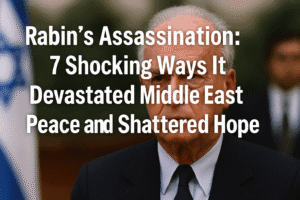Rabin’s Assassination: 7 Shocking Ways It Devastated Middle East Peace and Shattered Hope
The assassination of Israeli Prime Minister Yitzhak Rabin on November 4, 1995, marked a catastrophic turning point in Middle Eastern history. A champion of the Oslo Accords, Rabin sought peace through compromise, symbolized by his historic handshake with Palestinian leader Yasser Arafat in 1993. His murder by extremist Yigal Amir—who viewed concessions to Palestinians as treason—shattered fragile diplomatic progress and emboldened hardline factions.
Benjamin Netanyahu’s subsequent rise to power shifted Israel’s politics sharply rightward, prioritizing security over negotiation while settlements expanded in occupied territories. Three decades later, Rabin’s absence looms over a region still gripped by violence: the Gaza conflict, settler-driven displacement, and mutual distrust echo the unhealed wounds of his death. Rabin’s vision of a two-state solution, once a beacon of hope, now seems a distant relic, overshadowed by cycles of retaliation and radicalization. His legacy endures as a haunting reminder of peace’s fragility—and the devastating cost of its collapse.

Rabin’s Assassination: 7 Shocking Ways It Devastated Middle East Peace and Shattered Hope
On November 4, 1995, a single act of violence in Tel Aviv’s Kings of Israel Square unraveled decades of diplomatic effort and left a scar on the Middle East that still bleeds today. Yitzhak Rabin, Israel’s prime minister and a Nobel Peace Prize laureate, was assassinated by Yigal Amir, a 25-year-old extremist who viewed Rabin’s pursuit of peace as treason. Three decades later, the ramifications of that night continue to shape a region trapped in cycles of violence and mistrust.
The Bullet That Killed More Than a Leader
Rabin’s final speech at a peace rally echoed his unwavering belief in reconciliation: “Violence erodes the basis of Israeli democracy,” he declared, urging citizens to “choose peace.” Moments later, Amir fired two shots into Rabin’s back, driven by a twisted interpretation of Jewish law that branded Rabin a rodef—a threat to Jewish survival. The assassination did more than end a life; it extinguished a vision. Rabin’s death fractured Israel’s political landscape, emboldening hardliners and sidelining moderates who dared to negotiate.
The Oslo Accords: A Fragile Bridge to Peace
Rabin’s legacy is inextricably tied to the Oslo Accords, a groundbreaking framework born from secret talks in Norway. Signed in 1993, the accords recognized mutual legitimacy: Israel acknowledged the Palestine Liberation Organization (PLO) as the voice of Palestinians, while the PLO renounced violence and accepted Israel’s right to exist. The agreement established the Palestinian Authority, granting limited self-rule in parts of the West Bank and Gaza, and envisioned a gradual path to Palestinian statehood.
Yet Oslo’s promise collided with harsh realities. Hamas and far-right Israeli groups sabotaged progress through terror attacks and settlement expansions. Rabin’s own coalition frayed as settlers accused him of betrayal. By 1995, Oslo II aimed to deepen cooperation but faced mounting opposition. Rabin’s assassination became the fatal blow.
Netanyahu’s Rise and the Rightward Shift
Benjamin Netanyahu, then opposition leader, had stoked fury against Rabin, presiding over rallies where effigies of the prime minister donned Nazi uniforms. Rabin’s murder catalyzed Netanyahu’s 1996 electoral victory, marking a pivot toward security-centric policies. Settlements, which Rabin had deemed “a burden,” proliferated under subsequent governments. Today, Netanyahu’s coalition includes far-right ministers advocating annexation and opposing Palestinian statehood—policies diametrically opposed to Rabin’s vision.
The Unanswered “What If?”
Historians speculate that a surviving Rabin might have secured a 1996 mandate to advance peace. His military credentials—as a former general and defense minister—lent him credibility to make concessions others couldn’t. “He believed security came through partnership, not domination,” remarked Uri Savir, a key Oslo negotiator. Instead, Rabin’s successors prioritized expansion over diplomacy. By 2023, over 700,000 settlers occupied the West Bank, rendering a contiguous Palestinian state nearly impossible.
Legacy in a Divided Present
Rabin’s assassination remains a cautionary tale of how political violence can hijack a nation’s trajectory. For Palestinians, Oslo’s unfulfilled promises bred disillusionment, fueling support for armed resistance. For Israelis, Rabin’s death entrenched a security-first ethos, exemplified by the ongoing Gaza conflict, which has claimed over 53,000 Palestinian lives since October 2023.
Yet Rabin’s ideals still resonate. A 2015 poll revealed 76% of Israelis revered him as a leader, though only a third backed Oslo. His granddaughter, Noa Rabin, recently lamented, “His murder didn’t just kill him—it killed the belief that peace was attainable.”
Conclusion: The Ghost of Peace Past
Thirty years on, Rabin’s absence looms over a region trapped in the same cycle of bloodshed. His story underscores a bitter truth: peace requires not just treaties, but the courage to confront extremism within one’s own ranks. As settlements sprawl and rockets fly, Rabin’s plea—“Enough of blood and tears”—remains a haunting echo of what might have been.
In an era where dialogue is dismissed as naivety, Rabin’s unfinished mission challenges us to ask: Can the Middle East ever resurrect the hope extinguished on that Tel Aviv night? The answer, much like peace itself, remains agonizingly elusive.
You must be logged in to post a comment.